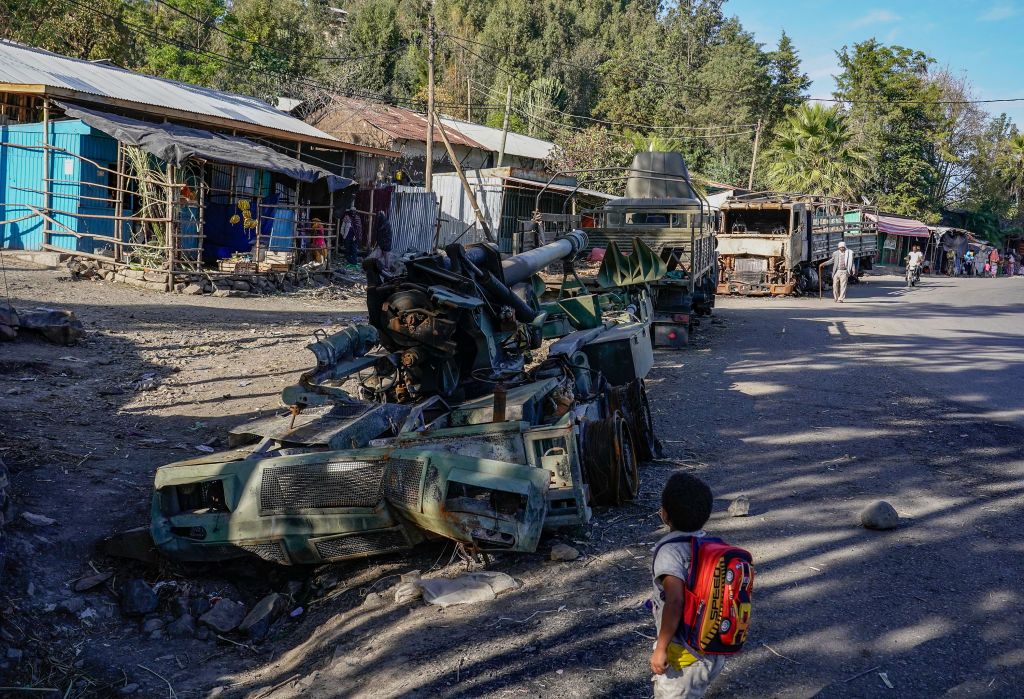Politics
Drones Over Ethiopia
The growing use of armed drones in Ethiopia and other backwater conflicts is linked to the recent war in Afghanistan.

Less than two months ago, the Ethiopian government was on the brink of defeat as Tigrayan forces closed in on the capital. Now the Tigrayan troops have turned about and withdrawn north back into Tigray. The government’s use of foreign-supplied unarmed aerial vehicles (UAVs) and armed drones appears to have played a significant role in reversing those spectacular gains made by the Tigrayan forces that had Prime Minister Abiy Ahmed calling on citizens to arms themselves and be ready to defend the capital, Addis Ababa.
“The precision-guided munitions are sure to have wreaked havoc among Tigray Defence Forces’ fire-support assets such as tanks and artillery,” says Stijn Mitzer, author of Oryx blog, a website investigating armed proliferation. “Although these munitions are less effective against spread out groups of fighters, the psychological effect of drone strikes likely did much to weaken the morale of TDF fighters.”
The use of armed drones raises questions about the collateral damage of civilian deaths that is all but inevitable from air strikes during a prolonged conflict. Through a combination of photographic evidence, investigations, and reports it’s been established that during the 14-month-long conflict the Ethiopian government has increasingly reached out to countries such as United Arab Emirates, Turkey, and Iran to supply cheap and effective drones, reports Al Jazeera: “As fighting drags on, the government, with its tiny air force of 22 combat-capable aircraft, seems to have also realised that air power and timely intelligence can make all the difference in a conflict—especially one fought over vast and often mountainous areas like in Ethiopia’s north.”
Photographic evidence has shown the presence of Chinese Wing Loong 2 UAVs at Ethiopian military bases. An investigation by Bellingcat, an independent international collective of researchers, investigators, and citizen journalists using open source and social media information to conduct investigations, indicated the presence in eastern Ethiopia of Iranian armed drones along with their ground control stations. Furthermore, there have been reports that the Ethiopian government reached out to Turkey for a number of its Bayraktar TB2 armed drones.
Turkey’s defence and aerospace exports to Ethiopia jumped in the first three months of 2021 to $51 million, Al Jazeera notes, with further increases in August and September. The hardware also comes with “a wealth of knowledge” from Turkish advisors and experts on how to best use these systems. Turkey has “the most operational experience in using drones in conventional military conflicts.” The TB2 has been used in three recent conflicts: western Libya, northern Syria, and Nagorno-Karabakh in Azerbaijan.
“Definitely the drones have been crucial,” says Alex de Waal, the director of the World Peace Foundation at Tufts University. “They were primarily effective in disrupting the TDF logistics. There is a single tarmac road from Tigray south all the way to Shewa, and during December there were about a dozen drones at any one time patrolling that road and shooting at any trucks moving along the road, making it extremely difficult and hazardous for the TDF to supply its front lines.” De Waal says he hears from Tigrayans repeated anecdotes about civilian casualties due to drones “from just about anywhere where there has been fighting … but these aren’t fully documented.”
From the beginning of Ethiopia’s conflict in November 2020, there have been reports of civilians killed by government airstrikes, including 64 people killed and 180 wounded after an airstrike on a market in Tigray in June 2021. The latest incident of civilian deaths occurred in the town of Mai Tsebriin on January 10th. Due to the government-enforced lockdown and communications blackout of Tigray, it has been exceedingly hard for journalists and other agencies to access the region and establish the veracity of events on the ground. Even when an airstrike has clearly occurred, it is difficult to parse whether it came from a jet or a drone, notes Mitzer.
“There is no way to tell that with 100 percent certainty until more evidence comes out,” says Mitzer on whether any of the airstrikes that killed Ethiopian civilians came from drones; his investigations are conducted remotely based on images of the aftermath of a strike. “I've been extremely careful in my reporting [and deciding on that link] because footage usually shows separate shots of the munitions' remains and the target, so it's impossible to assess whether the shots are actually connected.”
Sifting through the fog of war and parsing the use and impact of airpower is always difficult. The US air force is relatively transparent about the number of air sorties flown and munitions dropped in Afghanistan, having collated and published statistics for several years. However, the data don’t distinguish drones from other aircraft, notes a report by the Afghanistan Analysts Network, an independent non-profit policy research organisation. Furthermore, the data don’t take account of aircraft operated by other agencies such as the US army and CIA. “Working out who flies what and under whose command is difficult,” the AAN report says. Establishing such factors, including whether a drone strike caused civilian deaths, becomes even harder in a conflict as duplicitous and hidden as Ethiopia’s.
I learned about many of these challenges in 2009 when I coordinated the close air support (CAS) for the battle group I was attached to fighting in Afghanistan’s southern Helmand province. During the six-month tour that involved directing jets, attack helicopters, and drones to support our troops fighting the Taliban, I experienced the risks and reality—especially attending remotely conducted warfare—of that sanitized expression “collateral damage.” Like many others who fought there, I have lived with the consequences ever since.
My tour ended with me compiling a report for the brigade on civilian deaths in our battle group’s 160-kilometres-square area of operations caused by CAS. Considering the enormous number of bombs and missiles we let loose against the Taliban, the total of 16 civilians killed was arguably a bitter blessing and testament to the professionalism of the soldiers—especially the Joint Terminal Attack Controllers on the ground who directed the CAS attacks—and to the overall effort to avoid civilian deaths underpinned by strict rules of engagement (ROE) employed in adherence with the Law of Armed Conflict (LOAC).
ROE are limitations intended to ensure that military capability is applied reasonably in a way that limits collateral damage. The scope of limitations and permissiveness can vary—in some circumstances, the enemy may be engaged based on identification alone; in others, the enemy can only be engaged if he poses a threat to life. During my Afghanistan tour, our ROE required confirmation that a potential target was an enemy during combat when friendly forces came under attack. Engaging a target was not permitted if civilians would inevitably be harmed, in accordance with the LOAC which protect non-participants, prisoners, and the wounded. As I also learned in Iraq, ROE can be so restrictive that they become unpopular with soldiers who feel unable to fight effectively.
Ethiopia’s bloody conflict is poisoned by ethnic hatred and historical grievances, accompanied by related misinformation and propaganda. With atrocities committed by all sides, it is farcical to suppose the Ethiopian military applies such strict ROE or adherence to LOAC as the coalition forces did in Afghanistan, or that it’s as cautious in its use of armed drones. Nor are the militaries of the countries assisting Ethiopia likely to be any more prudent. “The reports I have were that the first wave of drones—November to December in 2020—were operated by Emiratis, and the current wave is partly operated by Turkish personnel,” de Waal says. “The reports I get are that they are using a lot of ammunition and not being discriminatory at all. But there’s so little documentation that it’s impossible to tell.”
The Ethiopian military is regarded as relatively professional compared to other African armies—there is no question that many of its officers and soldiers are exceedingly tough and capable. But it is simply not on par with the militaries of Western countries such as the US, UK, and Australia when it comes to the essentials, like a functioning chain of command, adherence to ROE and LOAC, and general transparency. In addition to propounding the likes of “courageous constraint” on the battlefield, Western militaries, all considered, have proved relatively open about their operations—including all the mistakes—during the recent conflicts of Iraq and Afghanistan.
Martin Plaut, a long-term commentator on the Horn of Africa and a fellow on the Institute of Commonwealth Studies, notes that the potential role of drones in Ethiopian civilian deaths from air strikes is a small fraction of the huge numbers of civilians dying from starvation caused by the conflict. He also notes that while drone use was a significant factor in the recent change in military fortunes—especially by providing intelligence about the ground situation—it was just one part of a multi-factored military equation. After their amazing advance, Tigrayans ended up facing multiple fronts while heavily exposed on their flanks. This was partly a consequence of exchanging the mountainous territory, within which they are such skilled irregular fighters, for open plains where they are vulnerable to conventional tactics. And Tigrayans were disadvantaged by the oldest military factor of all: a comparative lack of manpower. The Tigray population is six million while the rest of Ethiopia comprises about 100 million non-Tigrayans.
“The problem from the Tigray view is it has a limited population versus a limitless population,” Plaut says. “It can’t keep throwing out human waves. Ethiopia has no such concerns. The Tigrayans had plenty of weapons, having captured huge quantities, but food was becoming more of a problem.” Faced with a combination of old-fashioned military problems combined with more high-tech ones hitting their troops, Plaut says the Tigray commanders realised their position was untenable and ordered their forces to head back to Tigray, relinquishing all their hard-fought gains.
The growing use of armed drones in Ethiopia and other backwater conflicts (i.e., those that don’t affect the West yet) is linked to the recent war in Afghanistan, which the AAN report calls the birthplace of the armed drone:
Afghanistan in the late 1990s was the laboratory where the US developed armed drones as it searched for a way to deal with Osama bin Laden who was then ordering attacks on American targets from his safe haven in Kandahar. At that time, Washington was uneasy about ordering an assassination, especially one likely to result in civilian casualties. After 9/11, such doubts disappeared and it embraced drones, using them to carry out targeted killings of Islamist militants in many countries.
As US development and use of armed drones increased enormously after 9/11, the US became reluctant to share the advanced technology involved. As a result, the Al Jazeera article notes, the US “has been sidelined by regional competitors that manufacture armed drones that, while not as efficient, are still able to turn the tide.” The resulting trend sees “inexpensive and effective drones are making themselves felt on battlefields from the Caucuses and the Middle East to North Africa and beyond.”
The inferior technological prowess of drones like the Turkish TB2—compared to the top of the range Reapers and Predators that I worked with in Afghanistan—can be an advantage, certainly for cash-strapped governments like Ethiopia’s. “The TB2’s low relative cost and reliability allow several to be flown at once and enables maintenance of a near-constant presence over the battlespace, meaning that surprise tactics by one’s adversary will be spotted and much less likely to succeed,” Al Jazeera reports.
Debates about armed drone use remain fiercely contested. Whether drones are better or worse than other aircraft in reducing the risks of killing civilians is far from clear. “Supporters of drones and even some detractors point out that, because drones can loiter in ways that planes cannot, they allow for ‘tactical patience’ and more accurate targeting,” reports AAN. “All things being equal, therefore, there is less likelihood for civilians to be harmed.” However, AAN notes a study that compared strikes from drones and aircraft in Afghanistan from mid-2010 to mid-2011, which found that drones were causing ten times more civilian casualties. Sarah Holewinski of the Center for Civilians in Conflict, and co-author of the study, told the Guardian that the divergence resulted from fighter pilots getting more training in avoiding civilian casualties. “These findings show us that it’s not about the technology, it’s about how the technology is used,” remarked Holewinski. She added that the key factor was pilots being given clear directives and training in avoiding civilian casualties.
Another important factor that applies to an attack by any aircraft, manned or not, is the role played by the Joint Terminal Attack Controllers (JTAC). The JTAC controls the attack and directs the pilot, thereby also enabling the application of ROE and LOAC. A “Type 1 control” in JTAC parlance means the JTAC has eyes on both the aircraft and the target as the attack is coordinated. “Type 2” and “Type 3” controls occur when the JTAC cannot see the attacking aircraft at weapons release or the target. Instead, he must rely on a remote feed, usually a bird’s eye view of the target that is downlinked from a camera carried by the aircraft to the computer screen the JTAC is looking at. The difference between the Type 2 and 3 controls is the former refers to an individual attack coordinated remotely, while in a Type 3 control, after clearance is given from the JTAC, an aircraft can conduct multiple attacks on a specific target.
Type 1 controls are generally preferred given the JTAC on the ground has better awareness of the all the factors involved, especially the position of the enemy in relation to friendly troops and civilians, and how this all relates to the ROE in effect at the time. That said, a raging fire fight engulfing the JTAC as he is conducting a Type 1 control adds enormous pressure. A Type 2 or 3 control conducted from an operations room at a distance—in Nevada for many US drone attacks—affords a calmer environment and more thinking space. The downside is that a downlinked bird’s eye view of the battlefield can be confusing—while conducting a Type 2 control of a drone from the operations room in Afghanistan with a cup of tea at my side, I spotted what I thought was a Taliban burying an improvised explosive device in the road. Before committing to weapon release the drone’s pilot and I realised we were looking at a child playing in the dirt. It is not known whether the Ethiopian military employs the equivalent of JTAC-qualified soldiers to do Type 1 controls or whether it deploys drones remotely in the manner of Type 2 and 3 controls. Mitzer says it’s most likely the drones are being controlled remotely primarily.
Other ways in which civilian casualties may be increased or decreased by drone use—again, these factors apply to the use of any aircraft platform—include the likes of levels of intelligence on the ground and adherence to procedures. The AAN notes that a sharp rise in Afghanistan civilian casualties caused by US air operations in 2016 “was probably due to poorer intelligence” resulting from fewer ground troops—meaning the military was “not as knowledgeable as it used to be”—combined with a level of procedural failure creeping in. “It was not the weaponry itself that was the crucial factor, but rather, mission aims and guidelines, training and intelligence.”
In 2019, former director of the CIA Michael Hayden commented that “targeted killing using drones has become part of the American way of war.” That style of warfare continues to spread and now includes a conflict in Ethiopia that is already characterised by misinformation, confusion, and war crimes ranging from extrajudicial killings to massacres of civilians. How these developments reframe the waging of war around the globe, and the cost in civilian lives, remains fraught with uncertainty and huge implications.





